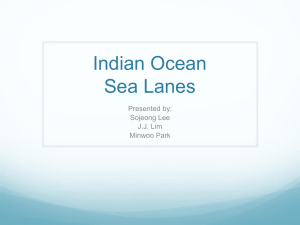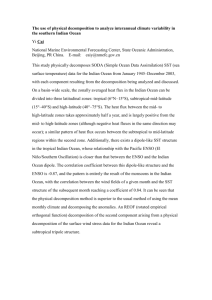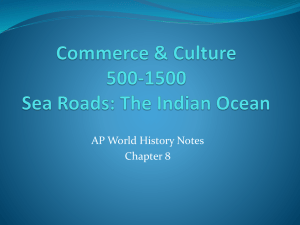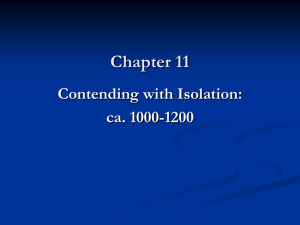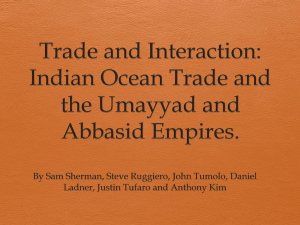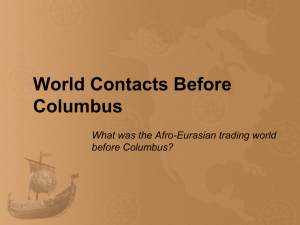Indian Ocean Trade
advertisement
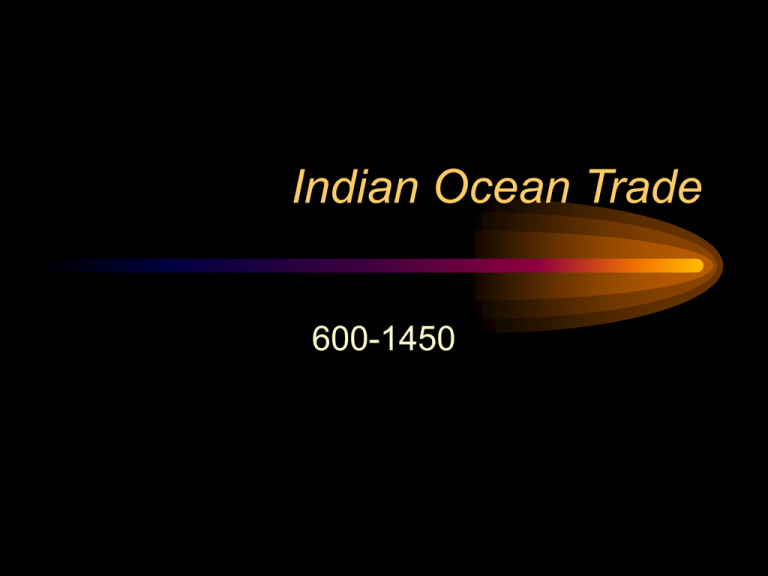
Indian Ocean Trade 600-1450 Indian Ocean Trade Southernization • Look back at your Indian Ocean articles and quotes. • What is important about the Indian Ocean? Unique in World History • “Zone of interaction” • First ocean to be crossed • “Sailor's ocean” – Warm water – Fairly placid waters – Wind patterns: one way = north of equator, the other = south of the equator Area around the ocean • Varied environments: – Tropical East Africa – Deserts around the Red Sea and Persian Gulf – Intensely wet southern India – Tropical rainforests of Southeast Asia Trade goods: • • • • Teak from India Mangrove swamps in East Africa Arabian horses to India Spices from Southeast Asia & Spice Islands • Frankincense from Arabia and Africa • ***Desired far beyond the Indian Ocean world People around the ocean • Madagascar settled by people from Southeast Asiaarrived via catamarans (1st millennium CE) • Slave trades & labor migrations – Slaves from East Africa to Arabia/India – From Southeast Asia to Southern Africa • Colonies of Romans in India; Arab Muslims & Jews in India; Indians and Chinese in SE Asia; Europeans in India, SE Asia, and East Africa… The things they carried… • Indian merchants brought Brahmin priests • Muslim scholars brought by Arab merchants • Christian merchants brought priests Borobudur (Java) • Largest Buddhist structure in the world • Built during Sailendras rule in Java (8th C CE—832) • Illustrates the wealth due to control of shipping lanes • Diffusion of Buddhism Borobudur (Java) • Illustrates Javanese Buddhism – Mahayana – Continual cycle of reincarnation – Low levels represent the earthly life – Continual path to enlightenment – Common Buddhist motifs: stupa, mandala – Unique to Java: sacred mountain Borobudur Stupa • Prambanan (Java) •After the fall of the Sailendra dynasty: Hindu dynasty • The Sanjaya. •Built Prambananphysical manifestation of Hindu trinity •In SE Asia: cultural fusion (syncretism) known as Hindu-Buddhism Angkor Wat •Cambodia •Cultural diffusion of Hindu-Buddhism throughout SE Asia. Angkor Wat • Built by Khmer Empire – Dedicated to Vishnu – Height ca. 1200 CE – Cultivated rice – Extensive irrigation system – Violent martial art – Flourished until conquered by Burma Hindu-Buddhism • SYNCRETISM • Religious and cultural fusion on both mainland and islands of SE Asia • Final flowering: 14th and 15th C in Majapahit • In Java, Islam replaced due to arrival of Muslim traders; by 16th C, nearly entire island converted. Hindu-Buddhism • Majahapit court and religious community moved to Bali; still flourishes there • Eventually, new syncretic religion: blending Sufi Islam with Hindu-Buddhism. – Prone to mysticism – Today: Indonesia = most populous Muslim nation; national symbol = Garuda (Hindi eagle deity) Conclusions • How is the spread of Hinduism/Buddhism in SE Asia similar to/different from the spread of Islam in Africa and Spain? • What can we learn based on the architecture? • What similarities does this hold with other cultures around the world?


